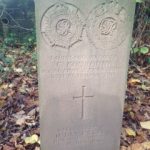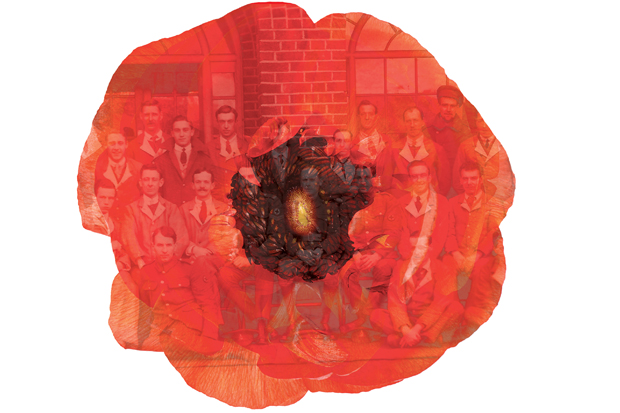The upcoming blog focuses on two more soldiers who died in Moss side and were buried locally.You can find out more about the stories uncovered in this research project with Manchester Metropolitan University is in the exhibition Moss Side and the Great War Remembered.
64563 Sapper Hugh Dempster
The bicycle thief.
Hugh Dempster was born around 1893 in the Ballymacarrett area of Belfast, close to the Harland and Wolff shipyards. He was a Presbyterian.
He was 22 and single when he joined the army in June 1915. He was living near Hillsborough, about 15 miles south east of Belfast, but travelled back to the city to enlist in 150th Field Company of the Royal Engineers. He joined up with his younger brother William, 20. They gave each other as their next of kin. Their father, Hugh Dempster snr, had died the year before the war started, and their mother Margaret had passed away ten years earlier.
The brothers were attached to the 36th Ulster Division, which was formed of members of the UVF. They were given consecutive regimental numbers: William was 64562 and his older brother Hugh was 64563.
Hugh was five foot seven inches tall, had tattoos on his left arm, and was a shoeing smith by trade, meaning he made and fitted horse shoes.
He and his brother left Ireland for England to do their military training. While stationed at Henley-on-Thames in Oxfordshire they both got into trouble.
William was reprimanded for “insolence to NCO”, a Sergeant Phoenix; and just days before sailing for France in early October his older brother hired a bicycle in Henley, and sold it in Reading.
No doubt Hugh, on his way to war on the Western Front, was not too concerned about the possible repercussions of a bicycle theft. But the owner of the bicycle hire shop had recorded Hugh’s name and company and contacted Oxfordshire Constabulary. The police wrote to Hugh’s commanding officer at Border Camp. He was tried by court martial on 18th October. He confessed to his crime and paid £3 by way of recompense.
It wasn’t the last time Hugh was in trouble with his superiors. On January 20th 1916 he was fined two days’ pay for “having clothing in a verminous condition” on the 8am parade. He also faced a court martial for overstaying his weekend leave.
Hugh Dempster left the Base Depot in Rouen, his port of entry to France, on 1st February 1916, and a month later he was transferred to 121st Company.
On 20th March Hugh was admitted to the 29th Casualty Clearing Station. We don’t know what he was suffering from, but he was transferred to hospital in England on 6th April.
There is no record of anyone coming to see him in the hospital visitors’ book and he died in Moss Side hospital on 5th June 1916.
The cause of death given in his medical papers is pneumonia, although presumably he must have had some mental complications for him to end up in Maghull.
The army sent a telegram to his bother William at an address in Dromore, County Down, informing him of Hugh’s death. William did not receive it. He was with 105 Field Company, Royal Engineers.
On 1st July 1916, William was reported missing. Less than a month after Hugh died his younger brother became part of one of the most notorious statistics in World War 1. Private William Dempster was one of the 19, 240 British soldiers to die on the first day of the Battle of the Somme, the worst single day in British military history.
Meanwhile his brother Hugh was sharing a Common Grave alongside Privates McCarthy and Rouse, in St Andrew’s churchyard (plot 504) with Private Charles Corquin, another Moss Side patient. Their Regimental Badges are once again inscribed on the headstone.

Caption: Photograph of Depmster & Courquin grave at St. Andrews
Copyright: Image courtesy of John Fay
T4/085460 Private Charles Corquin
Charles was born in Hampstead on Feb 7th 1877. He was the son of Louis Napoleon, which may have raised an eyebrow or two amongst the learned psychiatrists at Moss Side hospital.
Louis Napoleon Corquin was a boot and shoe maker, born in St Pancras, around 1844. He was married to Mary Ann and the couple had seven sons and two daughters. Charles was their third oldest child, born after his brothers Louis and Napoleon and before Herbert, Alice, Rosa, Sydney, Daniel and Annie.
Charles grew up with his large family on Upper Park Road in Camden.
By the time of the 1901 census he was working as a “light porter”, and living with his 55-year-old mother, his five younger siblings, and a lodger called Mary A. Smith.
His father had died the previous year. His mother died in 1910.
By 1911 he had moved out of the family home and was a single man living alone in 23, Gospel Oak Grove, Hampstead. He was working as a house porter.
He volunteered for service soon after war was declared.
The T4 prefix in Corquin’s service number means that he was involved with a Horse Transport company in the 4th Kitchener (New) Army, which was formed in November 1914. He was posted to France in April 1915.
We don’t yet know how he ended up in Maghull in 1916, but his family must have heard that he was ill. His sister Alice Teague left her home (and her husband) in 13 Lawn Road, Hampstead and made the journey to Maghull to see him, as evidenced by her entry in the visitor’s log.
On February 4th she spent the entire day at her brother’s bedside.
The next day he died.
The Unknown Soldiers
There are two stones marking the graves of four Moss Side patients in St Andrew’s churchyard. They are buried about ten yards away from Maghull’s most famous resident, Frank Hornby, the inventor of Meccano. It’s a beautiful spot. You might say they have been given pride of place.
According to the Moss Side committee minute book by March 1916 only four men had died in the hospital. But we know Hugh Dempster died in June, three months later. Furthermore, the minutes for June 14th 1916 record two deaths since the previous meeting, one of which is Dempster, the other unknown. Another death is recorded at the December 7th 1916 meeting, two more on March 15th 1917, one in May of the same year, one in July 1918, one in October, and the final two fatalities are recorded on May 9th 1919.
There were at least nine more men, in addition to the four mentioned here, who died in the hospital. Who were they? Where are they? Perhaps some were cremated, or had family near enough, or rich enough, to have them buried closer to home? Or perhaps after June 1916 the authorities didn’t have the resources to mark their graves in the way they had done for William McCarthy, Frank Rouse, Charles Corquin and Hugh Dempster?
Written by John Fay
Further researched by Keith Larkin
Edited by Amy Walling, Manchester Metropolitan University
Many thanks are due to Bruce Hubbard, Sidesman at St. Andrews for his help at the Churchyard. Bruce is also a Battlefield tour guide for France and Flanders.
Posted on 10 November 2018 under Moss Side Military Hospital







